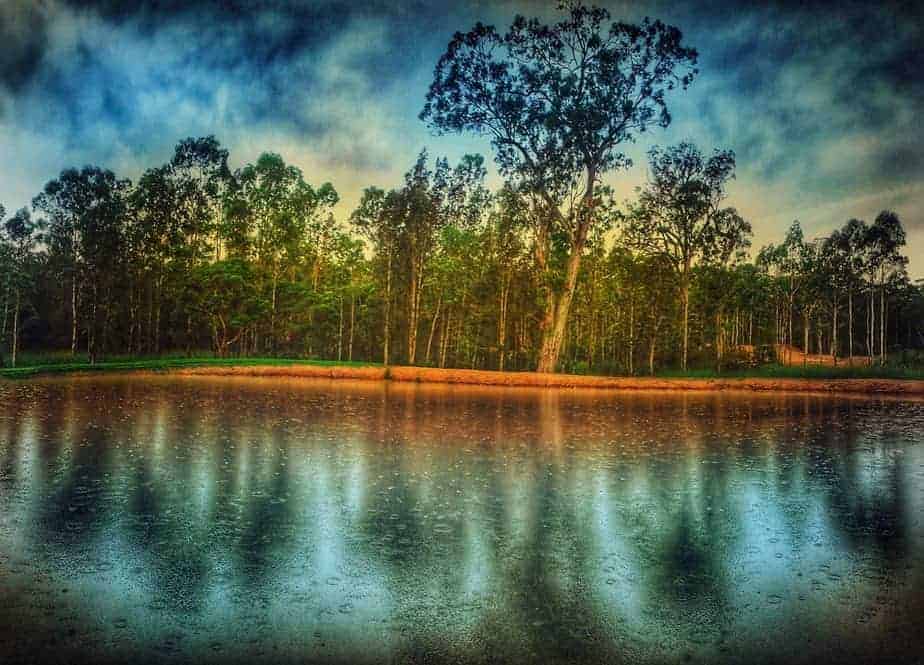Benefits of natural vegetation in dams
In some states of Australia, experts are saying a farm dam can lose anywhere from 1.3m to over 2m of water annually from evaporation. Here the question about evaporation management rises. With increasing length of droughts and higher mean temperatures, these estimates are only going to increase.

Whilst it is difficult to calculate a figure for the amount of water Australians lose from farm Dams each year due to differing climates, seasons, surface area to depth ratio of the dam, surrounding environment of the dam, and so on. It is safe to say it is significant enough to warrant the investigation of evaporation management remedies.
HOW DO WE MANAGE EVAPORATION?
There are a variety of products and methods available to reduce the rate of evaporation on your farm dam ranging from chemical additives to complete material covers. Each of these options has its own advantages and disadvantages.
Through certain scientific disciplines such as Biomimetics we are beginning to understand that nature already has in place several solutions, tried and tested through 4.5 billion year’s worth of trial and error (evolution), that provide refined solutions to any design problem we may encounter in modern society.

WHY CHOOSE PLANTS?
In this article we will explore the use of natural vegetation in evaporation management and it’s other benefits. The three effects that directly reduce the rate of evaporation are the provision of shade, the creation of windbreaks, and increasing local humidity.
As the vegetation spreads to an optimal coverage of 40%-60% of the water surface, the exposure to sunlight is reduced, cooling the water’s surface and slowing the vaporization that occurs as water molecules heat to the point where they may change into a gaseous state.
Secondly, windbreaks can be provided further out from the dam walls with trees, and closer in with smaller shrubs and grasses.
The trees are planted at a distance so their root structure will not compromise your impermeable dam wall and create potential leak points.
On the banks and outer rim of your dam, it is possible to use plants with more delicate, shallower root systems.
An investigation into your particular climate and soil is required for the selection of these plants to improve your evaporation management but some examples include wild rice, sedges, and rushes.
By reducing the force of the wind blowing across the water’s surface you are allowing the air above the water to remain more saturated if the air directly above your water surface has more saturation it has less capacity to take up water through evaporation.
A simplified example of this evaporation management method is if a sponge is already completely saturated with water it has no capacity to absorb more from its surroundings.
Connected to this idea of saturation is our third effect of proper evaporation management.
As your vegetation grows it will create it’s own microclimate, a combination of reduced wind, reduced sun exposure and plants transpiring will increase the local relative humidity around your dam.
By increasing the humidity you are saturating the air in the immediate vicinity of your dam.
ARE THERE OTHER BENEFITS?
We have discussed the direct benefits vegetation has on your dam for evaporation management, but the beauty of nature is that it always serves multiple functions or roles.
Through revegetating the land immediately surrounding your dam, it’s banks and the water itself you will discover a host of benefits ranging from, excess nutrients, toxins and metals being filtered from your water through the plant roots, creating habitat for wildlife which then creates a feedback loop of the wildlife increasing the biodiversity of the site and further enhancing the health of your dam ecosystem.
Through submerged plants photosynthesizing, your water is constantly oxygenated without the need of any pumps serving as a perfect evaporation management method.
With knowledge and design you can obtain a harvest from your dam, aquatic growing systems are thought to be the most productive systems available to humans.
If at times the vegetation requires thinning out, that excess can have a second life as nutrient dense mulch.
As we hear more and more about the costs of our carbon producing society you may rest assured that you are doing your part as those plants covering your dam are sequestering carbon through their growth.
And lastly a healthy functioning ecosystem that provides clean, clear water to swim in whilst listening to the warbles of birds and buzz of dragonflies is a much more aesthetically pleasing cover for your dam then some dull plastic sheet or potentially poisonous chemical additive.
